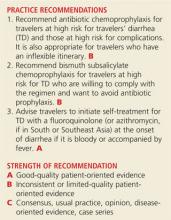A 40-year-old woman, a childhood immigrant from India, is seeking advice regarding her upcoming two-week trip to Mumbai. She is taking her two children, ages 16 years and 16 months, to visit their grandparents for the first time. She has made this trip alone a few times and has invariably experienced short bouts of self-limited diarrheal illness. She wonders what she might do to prevent travelers’ diarrhea. Her only medical problem is rheumatoid arthritis, which has been well controlled with methotrexate. Her children are healthy. What would you recommend?
Recommendations regarding travelers’ diarrhea (TD) address prevention and management. Prevention encompasses advice about personal behaviors and the use of chemoprophylaxis (antimicrobial and nonantimicrobial) and vaccinations. Since international travelers are known to treat themselves for diarrheal illnesses during their trips,1 recommendations regarding management should assume self-treatment and include the use of both antibiotic and nonantibiotic remedies. Pretravel recommendations will of course be most effective if they account for the individual’s risk for TD.
TD RISK
TD is generally defined as the passage of three or more loose stools in a 24-hour period, with associated symptoms of enteric infection (eg, fever, nausea, vomiting, or abdominal cramping). Defined in this manner, TD is thought to occur in 60% to 70% of individuals who travel from developed countries to less-developed countries.2-4 Risk for TD is influenced both by intrinsic personal factors and by factors specific to the trip.
Personal risk factors
Individual variation in susceptibility to TD might result from a genetic predisposition arising from single nucleotide polymorphisms governing various inflammatory marker proteins.5 A history of multiple episodes of TD, especially if fellow travelers were spared, can suggest this kind of individual susceptibility. Other factors that increase vulnerability to TD are immunodeficiency, achlorhydric states such as atrophic gastritis, and chronic use of proton pump inhibitors.6,7 However, the trip itself is much more important in assessing risk for TD.
Trip-related risk factors
The destination. The most salient risk factor for TD is the geographic destination. Regions of the world can be divided into TD risk strata2:
• Very high: South Asia
• High: South America, Sub-Saharan Africa
• Medium: Central America, Mexico, Caribbean, Middle East, North Africa, Southeast Asia, Oceania
• Low: Europe, North America (excluding Mexico), Australasia, Northeast Asia
Particularly notable countries, in descending order of risk, are Nepal, India, Myanmar, Bolivia, Sri Lanka, Ecuador, Peru, Kenya, and Guatemala.2
Dietary choices. Additionally, since travelers acquire TD by ingesting food or beverages contaminated with pathogenic fecal microbes, dietary behaviors during the trip affect their susceptibility. At least risk are business travelers and tourists who confine their activities to more affluent settings in which food and beverages are prepared and stored hygienically.1,4,8,9 At greater risk are travelers who immerse themselves in local culture, visiting locations that are more impoverished and not as well equipped with sanitation systems, especially if their stay lasts at least two to three weeks.1,4,8,9
Also, the older a traveler is, the lower his or her risk for TD.1,9 An exception to this might be infants whose diet consists solely of breast milk or formula prepared under sanitary conditions.
Continued on next page >>

